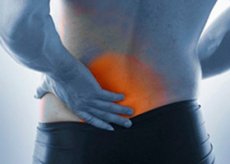Pseudospinal Pain
Last reviewed: 23.04.2024

All iLive content is medically reviewed or fact checked to ensure as much factual accuracy as possible.
We have strict sourcing guidelines and only link to reputable media sites, academic research institutions and, whenever possible, medically peer reviewed studies. Note that the numbers in parentheses ([1], [2], etc.) are clickable links to these studies.
If you feel that any of our content is inaccurate, out-of-date, or otherwise questionable, please select it and press Ctrl + Enter.

Back pain and / or leg pain can be a symptom of ailments:
- System
- Visceral
- The Vascular
- Neurological disorders
- Pseudospinal pain is not uncommon
Aneurysm of the abdominal aorta
- 1-4% in the population older than 50 years
- 1-2% for all men who died at the age of about 65 years
- Abdominal pain with irradiation in the hip
- In 12% of back pain
- Diagnosis: ultrasound or CT scan
Endometriosis
- Reproductive age
- Pelvic pain
- Abdominal pain
- Back pain 25-31%
- Diagnosis: Laparoscopy
- treatment: oral contraceptives, danazol (testosterone analogue)
Other disorders
- Fibromyalgia 2%
- Trochanter bursitis - 25%
- Inflammatory diseases of the pelvic organs
- Prostatitis
- The frequency during life is 50%
- Nephrolithiasis 3%
- Pancreatitis and pancreatic cancer
- Pain in the epigastrium with irradiation in the back
Infectious diseases of the spine
Osteomyelitis
- Rare cause of back pain
- 1: 20,000 for hospital statistics
- The most frequently caused by gram-positive cocci
- Urologic infections are the most frequent cause
- Hematogenous spread (excluding vertebral injection)
- Almost always there is a pain in the back
Discitis
- Osteomyelitis and / or hematogenous spread
- Surgical or diagnostic procedures
Infectious lesions of the spine
- Neck - 8%
- Cervico-thoracic <1%
- Thoracic - 35%
- Chest-lumbar - 8%
- Lumbar - 42%
- Lumbosacral - 7%
- Sacrificial <1%
Sources of vertebral infections (in half of all cases can not be established)
- Genitourinary tract - 46%
- Leather - 19%
- Respiratory tract - 14%
- Surgery of the spine - 9%
- Blood - 4%
- Intravenous infusions - 3%
- Teeth - 2%
- Bacterial endocarditis - 1%


 [
[